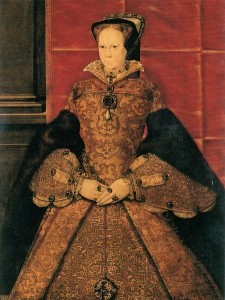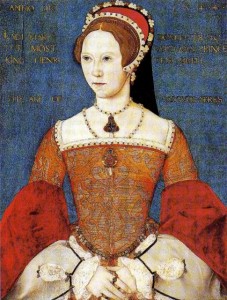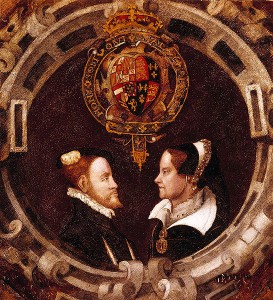 Thank you to historian and author Conor Byrne for writing this article to commemorate the anniversary of Mary I’s birth on this day in 1516.
Thank you to historian and author Conor Byrne for writing this article to commemorate the anniversary of Mary I’s birth on this day in 1516.
Mary, daughter of Henry VIII and Katherine of Aragon, was born at Greenwich Palace on 18 February 1516. Last year marked the five hundredth anniversary of her birth, and a collection of essays was published by Palgrave Macmillan, entitled “The Birth of a Queen”. This collection is the latest in a series of works reappraising England’s first queen regnant. Judith Richards, Anna Whitelock and Linda Porter have produced sympathetic and sound biographies of Mary, while an impressive range of sources, both textual and material, have been drawn on in academic studies to improve and develop our understanding of this much-maligned figure. In 1516, although it would have been anticipated that the baby Mary would one day be a queen, perhaps as the wife of a French or Spanish king, it would not have been expected that she would actually rule in her own right as queen regnant. Yet that is exactly what she did, following in the footsteps of her celebrated maternal grandmother, Isabella of Castile.
It is often assumed that Henry VIII was profoundly disappointed by the birth of a daughter, and perhaps he was, because his wife was now thirty years of age and had endured a series of unsettling miscarriages and stillbirths dating back to 1510. After the birth of Mary, the queen conceived only once more, and a daughter was born dead in the winter of 1518. However, there is a great deal of evidence that complicates our traditional understanding of how Henry viewed his young daughter and her place in the Tudor dynasty. Early on, the princess was betrothed to François, Dauphin of France. Her mother ensured that Mary was provided with an excellent education, as befitted the daughter of humanist rulers, and consulted the renowned humanist Juan Luis Vives for advice. As later became apparent during the annulment crisis, Katherine firmly believed that her daughter could rule in her own right, but at this stage, she appears to have been concerned that Mary should be educated for her future role as queen consort, whether of France or elsewhere.
 By 1525, when she was nine years old, Mary was honoured as de facto Princess of Wales and departed for Ludlow, to preside over the Council of Wales and the Marches. The princess was appointed a royal household during the period of time that she spent there, and was honoured with many of the royal prerogatives usually reserved for a prince of Wales. Unlike her younger half-sister Elizabeth, who never presided over such a household, Mary was effectively being educated to rule. This development is explicable in view of her betrothal to Charles, son of Philip of Castile. Henry seems to have accepted that he would never have sons by Katherine, but he continued to honour Mary as his heir, at least until 1527.
By 1525, when she was nine years old, Mary was honoured as de facto Princess of Wales and departed for Ludlow, to preside over the Council of Wales and the Marches. The princess was appointed a royal household during the period of time that she spent there, and was honoured with many of the royal prerogatives usually reserved for a prince of Wales. Unlike her younger half-sister Elizabeth, who never presided over such a household, Mary was effectively being educated to rule. This development is explicable in view of her betrothal to Charles, son of Philip of Castile. Henry seems to have accepted that he would never have sons by Katherine, but he continued to honour Mary as his heir, at least until 1527.
The annulment crisis, however, complicated Mary’s life. It is worth emphasising that, just as her father’s subjects continued to regard Katherine as the rightful Queen of England – even after the Boleyn marriage had taken place – Mary continued to be viewed, both at home and abroad, as a princess of England and as her father’s rightful heir. This conviction is demonstrated most clearly, perhaps, in the outbreak of religious and social revolt in the autumn of 1536, usually known as the Pilgrimage of Grace, which demanded that Henry restore his eldest daughter to the succession. In diplomatic letters, Mary was usually referred to as ‘the Princess’, whereas her younger half-sister was ‘Anne Boleyn’s daughter’ or ‘the bastard’. This tradition of belief in Mary’s legitimacy was not short-lived. Even during the last years of the sixteenth-century, and early years of the seventeenth, when Mary was long dead, disaffected Catholics continued to honour her as the true queen, and disparaged Elizabeth as an unlawful usurper, the offspring of a convicted traitor.
Modern historiography has gradually moved away from a simplistic and flawed understanding of Mary as an unintelligent, bigoted and cruel queen, the ‘Spanish Tudor’, to an awareness that she was highly cultured, courageous, resilient, and determined to rule as her father’s rightful heir. During her childhood, she was educated to rule in her own right, and the English population at large supported her claim to rule following the death of her brother Edward VI. In 1553, Mary was widely supported in her bid to depose Lady Jane Grey, and her success is often unacknowledged: hers was the only successful rebellion directed against the government in Tudor England. Mary’s accession was greeted with bonfires, parties and celebrations of joy, a measure of her popularity and esteem. She later further demonstrated her courage and resilience during Wyatt’s rebellion the following year, when she rallied her subjects to her cause, which confirmed her capability as a political leader.
Paradoxically, according to the traditional narrative, it was shortly after her coronation that everything began to go wrong for Mary, at least in part due to her own mistakes. By reinstating the medieval heresy laws, and in seeking to restore papal authority in England, Mary crucially underestimated and ignored the popularity of religious reform in England in the wake of the Reformation. Her decision to burn heretics was both cruel and unprecedented; indeed, as John Foxe memorably captured in his Acts and Monuments, the bonfires were not ‘English’, but were symptomatic of Spanish cruelty and bloodshed. Mary’s decision to marry Philip of Spain, moreover, directly ignored the widespread antipathy in the kingdom to a marital alliance with Spain, and the resulting involvement in Philip’s costly wars led to the loss of Calais, a final humiliation of the queen and a confirmation that she was not simply not up to the task of ruling.
Of course, the traditional narrative is questionable, and modern historians have gradually taken it apart by considering a wide range of contemporary evidence. Firstly, despite the break with Rome and the Edwardian Reformation, Catholicism remained the majority religion in England, and the queen’s decision to restore the medieval heresy laws was widely supported, although the restoration of papal authority may have been less popular, especially among the nobility and gentry, who had benefited financially as a result of the dissolution of the monasteries and religious houses. Historians such as Eamon Duffy have provided detailed evidence of the popularity of Catholicism even during the reign of the fiercely anti-papal Edward VI. Moreover, overreliance on John Foxe’s powerful narrative has, perhaps, meant that hostility to the burnings has been exaggerated. Contrary to the traditional narrative, heretics had been burned in England since the fifteenth-century, so Mary’s decision to have those who committed heresy incinerated was neither unprecedented nor ‘un-English’. Her exact involvement, and the nature of her involvement, remains open to question.
The Spanish marriage, moreover, was not as widely unpopular as has been traditionally suggested. In particular, the work of Alexander Samson and Corinna Streckfuss has demonstrated that the marriage was widely celebrated both at home and abroad, and Philip was appreciated as an intelligent, charismatic and moderate ruler. Many English soldiers fought in his wars and continued to receive pensions from him well into the reign of Elizabeth I. Moreover, many of Mary’s subjects hoped that she would provide the realm with an heir, and who she might have married, with the exception of Philip, is a difficult question. Anglo-Spanish marital alliances had occurred regularly among the two royal houses; indeed, the marriage between Arthur Tudor and Katherine of Aragon was met with acclaim. The key issue appears to have been that of Mary’s status as queen regnant. Contemporaries believed that the wife should submit unconditionally and unquestioningly to her husband, who was her superior. Just as the (male) monarch governed the kingdom, so the husband governed the household. As the first queen regnant of England, Mary faced the question of what it meant for a woman to hold a traditionally male position, and later, how to reconcile her role as a wife with that of monarch.
 Evidence indicates that, by and large, Mary succeeded in answering this question. She enjoyed precedence before Philip, and the marriage treaties undoubtedly circumscribed his authority as king consort of England. Mary was represented both as a queen and as a king, or as a prince, as her half-sister was also later represented. As one of her contemporaries noted, Mary was ‘a queen, and by the same title, a king also’. Moreover, Mary’s military successes have often been forgotten or downplayed, as Anna Whitelock notes. The loss of Calais in early 1558 has probably been exaggerated, for it was expensive to maintain; meanwhile, the queen enjoyed successes including that of the battle of St. Quentin. Unlike her half-sister, who was often reluctant to engage in war, Mary showed a distinct enthusiasm for it. She was, as Whitelock explains, a military queen, and again perhaps sought to emulate her grandmother, the warrior queen Isabella of Castile.
Evidence indicates that, by and large, Mary succeeded in answering this question. She enjoyed precedence before Philip, and the marriage treaties undoubtedly circumscribed his authority as king consort of England. Mary was represented both as a queen and as a king, or as a prince, as her half-sister was also later represented. As one of her contemporaries noted, Mary was ‘a queen, and by the same title, a king also’. Moreover, Mary’s military successes have often been forgotten or downplayed, as Anna Whitelock notes. The loss of Calais in early 1558 has probably been exaggerated, for it was expensive to maintain; meanwhile, the queen enjoyed successes including that of the battle of St. Quentin. Unlike her half-sister, who was often reluctant to engage in war, Mary showed a distinct enthusiasm for it. She was, as Whitelock explains, a military queen, and again perhaps sought to emulate her grandmother, the warrior queen Isabella of Castile.
Mary has also been credited with other successes, including her reforms to the coinage and her extension of royal authority into the localities. She also successfully managed her parliaments and made important reforms to the navy. It was not Mary’s fault, moreover, that she failed to provide her husband with an heir; she had married at thirty-seven years of age, a late age to marry for the first time in sixteenth-century England, and her reign lasted only five years. In different circumstances, perhaps Mary’s reign might have ended differently.
As it was, her death in 1558 was swiftly followed by the eradication of all traces of her. Moreover, as historians have noted, Elizabeth learned many lessons from Mary and drew on the iconography associated with her half-sister, whether religious or gendered. She was likened to Judith, Deborah and Old Testament kings; it is often forgotten, or downplayed, that Mary had also been compared to these figures, including at her coronation in 1553. Elizabeth’s unquestioned succession to the throne was made possible by Mary’s demonstration that a woman could successfully rule in her own right. Mary made the idea of female monarchy familiar, rather than being a strange or dangerous concept.
Unlike her half-sister, Mary had been educated to rule and, as a young girl, had been appointed as the de facto princess of Wales. Her father betrothed her to a French dauphin and a Habsburg prince and, at least until 1527, Mary was honoured by her father as his heir. Even after the annulment and the break with Rome, in the eyes of many, Mary was the true princess, the rightful heir. This recognition was demonstrated in the Pilgrimage of Grace and during the 1553 crisis, when Mary successfully drove Lady Jane Grey and her supporters from the centre of power. Although she only ruled for five years, Mary demonstrated that a woman could successfully rule England in her own right. Her marriage to Philip was not the unmitigated disaster that it has traditionally been presented as, and nor was her decision to restore the medieval heresy laws and papal authority a testament to her failure to grasp the changed religious climate of the 1550s. In her speeches, in her foreign policy, in her parliaments, in her marital negotiations, in her legislation and in her ceremonies, Elizabeth drew on the precedents established by Mary and on the language employed by her half-sister. As the first queen regnant of England, Mary is perhaps one of Britain’s most important monarchs and is certainly one of its most underappreciated.
Conor Byrne studied History at the University of Exeter. He is the author of Katherine Howard: A New History and Queenship in England, both published by MadeGlobal. Since 2012 he has run a historical blog and was formerly editor of “Tudor Life” Magazine. His research to date specialises in late medieval and early modern European history, with a focus on gender, sexuality and the monarchy.
Go to http://getbook.at/queenship to find out more about his latest book Queenship in England 1308-1485.